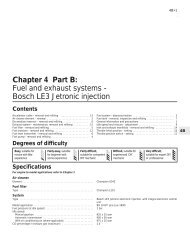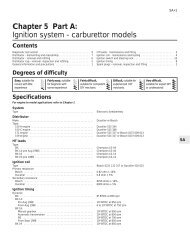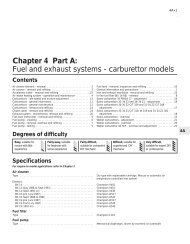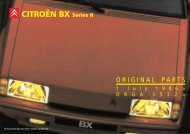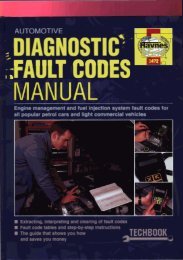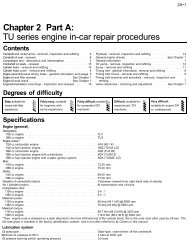Chapter 4 Part D: Fuel and exhaust systems - Magneti Marelli injection
Chapter 4 Part D: Fuel and exhaust systems - Magneti Marelli injection
Chapter 4 Part D: Fuel and exhaust systems - Magneti Marelli injection
Create successful ePaper yourself
Turn your PDF publications into a flip-book with our unique Google optimized e-Paper software.
4D•6 <strong>Fuel</strong> <strong>and</strong> <strong>exhaust</strong> <strong>systems</strong> - <strong>Magneti</strong> <strong>Marelli</strong> <strong>injection</strong><br />
16.4 Oil filler/breather cap retaining nut (arrowed) 16.6 Slackening coolant hose retaining clip from front of inlet<br />
manifold - MAP sensor hose arrowed<br />
5 Undo the bolt securing the wiring/hose<br />
support bracket to the top of the manifold <strong>and</strong><br />
position the bracket clear of the manifold.<br />
6 Disconnect the coolant hose <strong>and</strong> the MAP<br />
sensor vacuum hose from the front of the<br />
manifold (see illustration).<br />
7 Undo the six manifold retaining nuts <strong>and</strong><br />
remove the manifold from the engine.<br />
Remove the gasket <strong>and</strong> renew it.<br />
8 Refitting is a reverse of the removal<br />
procedure, noting the following points.<br />
a) Ensure that the manifold <strong>and</strong> cylinder<br />
head mating surfaces are clean <strong>and</strong> dry<br />
before fitting the new gasket.<br />
b) Ensure that all relevant hoses are<br />
reconnected to their original positions,<br />
<strong>and</strong> are securely held (where necessary)<br />
by the retaining clips.<br />
c) On completion, refill the cooling system.<br />
Exhaust manifold<br />
9 Refer to Section 14 in <strong>Part</strong> B of this <strong>Chapter</strong><br />
17 Exhaust system -<br />
maintenance, removal <strong>and</strong><br />
refitting<br />
2<br />
Refer to Section 14 in <strong>Part</strong> C of this <strong>Chapter</strong>.<br />
18 Exhaust emission control<br />
system - general information<br />
<strong>and</strong> testing<br />
5<br />
General information<br />
1 To minimise the amount of pollutants which<br />
escape into the atmosphere, a catalytic<br />
converter is incorporated into the <strong>exhaust</strong><br />
system. The system is a “closed-loop” type, a<br />
lambda sensor in the <strong>exhaust</strong> system providing<br />
the engine management system ECU with<br />
constant feedback, thus enabling it to adjust<br />
the mixture <strong>and</strong> provide the best possible<br />
conditions for the converter to operate.<br />
2 The lambda sensor has a built-in heating<br />
element, controlled by the ECU through the<br />
relay assembly to quickly bring the sensor’s tip<br />
to an efficient operating temperature. The<br />
sensor’s tip is sensitive to oxygen <strong>and</strong> sends<br />
the ECU a varying voltage depending on the<br />
amount of oxygen in the <strong>exhaust</strong> gases. If the<br />
inlet air/fuel mixture is too rich, the <strong>exhaust</strong><br />
gases are low in oxygen, so the sensor sends a<br />
low-voltage signal. This voltage rises as the<br />
mixture weakens <strong>and</strong> the amount of oxygen in<br />
the <strong>exhaust</strong> gases rises. Peak conversion<br />
efficiency of all major pollutants occurs if the<br />
inlet air/fuel mixture is maintained at the<br />
chemically-correct ratio for the complete<br />
combustion of petrol of 14.7 parts (by weight) of<br />
air to 1 part of fuel. The sensor output voltage<br />
alters in a large step at this point, the ECU using<br />
the signal change as a reference point <strong>and</strong><br />
correcting the inlet air/fuel mixture accordingly<br />
by altering the fuel injector pulse width.<br />
Testing<br />
3 Regular checks of the lambda sensor’s<br />
operation should be performed. This can be<br />
done only by attaching Citroën diagnostic<br />
equipment to the sensor wiring <strong>and</strong> checking<br />
that the voltage varies from low to high values<br />
when the engine is running. Do not attempt to<br />
“test” any part of the system with anything<br />
other than the correct test equipment.<br />
19 Evaporative emission control<br />
system - general information<br />
2<br />
<strong>and</strong> component renewal<br />
General information<br />
1 To minimise the escape of unburned<br />
hydrocarbons into the atmosphere, an<br />
evaporative emissions control system is<br />
incorporated in the <strong>Magneti</strong> <strong>Marelli</strong> engine<br />
management system. The fuel tank filler cap is<br />
sealed <strong>and</strong> a charcoal canister is mounted<br />
underneath the right-h<strong>and</strong> wing to collect the<br />
petrol vapour generated in the tank when the<br />
vehicle is parked. This vapour is stored until it<br />
can be cleared from the canister (under the<br />
control of the engine management system<br />
ECU, via the purge control valve) into the inlet<br />
tract, to be burned by the engine during<br />
normal combustion.<br />
2 To ensure that the engine runs correctly<br />
when it is cold <strong>and</strong>/or idling, <strong>and</strong> to protect<br />
the catalytic converter from the effects of an<br />
over-rich mixture, the purge control valve is<br />
not opened by the ECU until the engine has<br />
warmed up. The valve solenoid is then<br />
modulated on <strong>and</strong> off to allow the stored<br />
vapour to pass into the inlet tract.<br />
3 If the system is thought to be faulty,<br />
disconnect the hoses from the charcoal<br />
canister <strong>and</strong> purge control valve <strong>and</strong> check<br />
that they are clear by blowing through them. If<br />
the purge control valve or charcoal canister are<br />
thought to be faulty, they must be renewed.<br />
Charcoal canister - removal <strong>and</strong><br />
refitting<br />
4 Disconnect the battery negative terminal.<br />
5 Chock the rear wheels, then jack up the<br />
front of the vehicle <strong>and</strong> support it on axle<br />
st<strong>and</strong>s (see “Jacking <strong>and</strong> vehicle support”).<br />
Remove the right-h<strong>and</strong> front roadwheel.<br />
6 Release the retaining clip(s) <strong>and</strong> disconnect<br />
the hoses from the canister.<br />
7 Undo the retaining screw(s) <strong>and</strong>/or release<br />
the retaining clips (as applicable), then free<br />
the canister assembly from its retaining<br />
bracket <strong>and</strong> remove it from underneath the<br />
wheel arch.<br />
8 Refitting is a reverse of the removal<br />
procedure. Ensure that the hoses are<br />
correctly routed <strong>and</strong> securely reconnected.<br />
Purge valve - removal <strong>and</strong><br />
refitting<br />
9 Disconnect the battery negative terminal.<br />
10 Disconnect the wiring connector from the<br />
purge valve, situated just behind the alternator.<br />
11 Disconnect the inlet <strong>and</strong> outlet hoses,<br />
then remove the valve from the engine<br />
compartment.<br />
12 Refitting is a reverse of the removal<br />
procedure. Ensure that the inlet <strong>and</strong> outlet<br />
hoses are securely reconnected.




